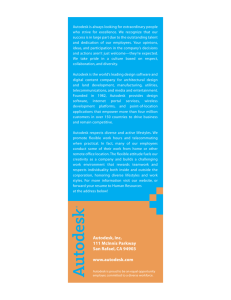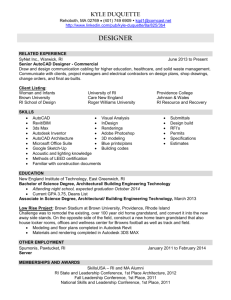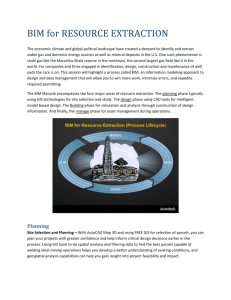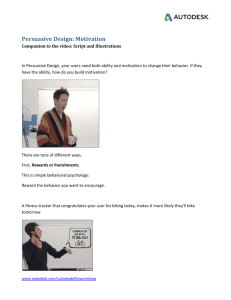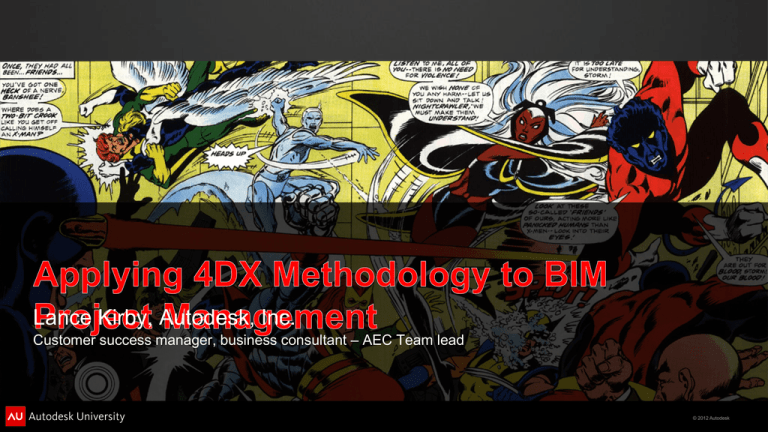
Lance Kirby, Autodesk, Inc.
Customer success manager, business consultant – AEC Team lead
© 2012 Autodesk
4DX practices have been tested and refined by thousands of
teams over many years. When a BIM Project Team follows
these disciplines, they will achieve outstanding results—
regardless of the deliverables required. 4DX represents a
new way of thinking and working that is essential to thriving
in today’s AEC marketplace.
How we doing on our BIM
projects?
how well are we
performing?
© 2012 Autodesk
•
Critically focus on process to become a highly functional BIM team.
•
Act on the lead measures that impact goal achievement for your BIM project.
•
Create compelling, motivating metrics to focus, motivate, and inspire team
members.
•
Establish specific responsibilities for the team to foster accountability toward the
BIM deliverables.
© 2012 Autodesk
Lance Kirby, Autodesk, Inc.
•
Customer Success Manager
• Business Consultant – AEC Team Lead
Architect with Rosser International and Perkins+Will
Projects in justice, commercial, education, sports, aviation and healthcare
Joined Revit Technologies in 2000, Autodesk in 2002. Helped develop Revit
Trained and mentored thousands of architects and engineers in the use of BIM.
Worked with firms such as AECOM, ADD Inc., Balfour Beatty, Ballinger, Cannon Design, CDM Smith, Dar, DLR, Ellerbe
Becket, exp, Friedmutter, Gensler, Gilbane, GSA, HOK, HKS, Jacobs, Kling Stubbins, MWH, NBBJ, Perkins+Will, RTKL,
Skanska, SNC-Lavalin, SOM, URS, USACE, VA, and the Zeidler Partnership.
B. Arch from Mississippi State U. & the Technical U. of Budapest.
© 2012 Autodesk
•
•
Intro
Define: THE 4 PRINCIPLES OF EXECUTION
•
Background
• Focus on the wig’s
• Act on lead measures
• Keeping a compelling scorecard
• Create a cadence of accountability
•
Implementing BIM requires a unique
combination of skills that are not easily
found; the integration of AEC process,
technology
and policy,
expertise in a single
context
Construct: Applying these principles
•
Stages of change
• Installing the disciplines
•
Adopt: team simulation
• outro
© 2012 Autodesk
What’s the most
important goal for our
team using BIM?
TO improve the qualities of
our deliverables?
What about producing
them quicker?
© 2012 Autodesk
•
BIM teams are still teams
• Learning tools versus processes
• Respelled ‘cad’, ‘B-I-M”
• Have the lag, but not the lead?
• What’s the point anyway?
Is it Our Tools?
Is it Our
processes?
Our people???
© 2012 Autodesk
•
Define
•
•
•
Construct
•
•
•
team creates the scope, goals, and performance targets for the project
Determine current state, and influencers that support/challenge the objectives
Evaluate inputs and outputs to identify needed processes
Develop potential solutions
Adopt
•
•
Pilot the solutions
Audit the Pilots, Make improvements
© 2012 Autodesk
© 2012 Autodesk
•
One: Focusing on the Wildly Important
•
Two: Acting on Lead Measurement
•
Three: Keeping a compelling Scoreboard
•
Four: Creating a Cadence of Accountability
© 2012 Autodesk
•
•
•
•
•
•
•
Focus on the wildly important 2-3 goals achieved with excellence
Going after more is less effective
If every other area of our operation was static, what is the one area where change would
have the greatest impact?
Rule 1: no team focuses on more than two WIG's at a time,
Rule 2: the battles you choose must win the war
Rule 3: senior leaders can veto, but not dictate
Rule 4: all WIG's must have a finish line in the form of X to Y by when
© 2012 Autodesk
•
•
Act on lead measures
• Focus on the lead measures early and often
Lead measures are predictive and influenceable
• Select activities that make the most impact
To be on time, we
must meet each
deadline phase
To be on budget,
we must perform
© 2012 Autodesk
How do we know if we are
achieving our goals?
Keep a Compelling Scoreboard
•
•
•
•
Is it simple?
Is it visible?
Does it show lead and lag measures?
can winning or losing be determined at a glance?
IF there was some way to
know,…like a chart or
diagram.
© 2012 Autodesk
Create a cadence of accountability
I’ve agreed to support the
goal,
WIG Session: holding each team member
accountable for advancing the lead measures
based on 2 rules:
•
Regardless of the
whirlwind!
•
time should be consistent
should be the sole focus
© 2012 Autodesk
What does a WIG Session look like?
According to the Scoreboard: probability
of success is 97%!
•
Agendas should include:
• Account: Report on commitments
• Review the scoreboard
• Plan: Clear the path and make new
commitments
© 2012 Autodesk
•
•
•
•
•
Stage 1: Getting clear-commit to a new level of performance
Stage 2: Launch-intense focus is needed at the start to ensure momentum
forward
Stage 3: Adoption-as momentum picks up, enthusiasm increases
Stage 4: Optimization-Looking for ways to continually improve
Stage 5: Habits
© 2012 Autodesk
•
•
•
•
Be a model of focus on the WIGs
Identify high-leverage lead measures
Create a players' scoreboard
Schedule WIG sessions at least weekly and hold to them
Team Meeting time
We’ll review
commitments to
moving the W.I.G.’S
© 2012 Autodesk
•
•
needed at the start to ensure momentum forward
Recognize that the launch phase requires focus and
• energy from the leader
• Trust the process
• Identify your models, potentials, and resisters
(Identify easy wins)
How can I lead
effectively?
© 2012 Autodesk
At the Weekly WIG
session…
Are we on track this
week?
•
Focus first on adherence to the process, then results
• Make commitments to hold each other accountable
Track results weekly on a scoreboard
• Makes adjustments as needed
• Invest in potentials through additional training and mentoring
• Answer straightforwardly resisters, clearing a path
We’ll see…
© 2012 Autodesk
•
•
Encourage and recognize improvement to lead
measures
Recognize excellent follow through and celebrate
successes
• Encourage team members to clear each others
paths
• Recognize potentials becoming models
Great job, team. Let me know if
you need my help.
Thanks, I will. Off to
the project meeting.
© 2012 Autodesk
•
•
•
•
•
•
•
•
Celebrate the accomplishments of the WIG
Formalize 4DX by moving on new WIG
Reinforce 4DX creates superior performance by acting on lead
measures
Move the Middle
Models-engaged top performers
Resisters-disengaged poor performers
Potentials-ready to become top performers
Leadership clarity, launching, adopting, optimizing, habits
© 2012 Autodesk
•
One: what is your enterprise’s/team’s goal(s) for using BIM?
•
Two: What do you change in your processes that change your projects’
outcomes?
•
Three: what metrics do you use to determine when your teams are under- or
over-performing?
•
Four: What motivates your teams to achieve in the BIM environment?
© 2012 Autodesk
© 2012 Autodesk
•
One: what one Wildly Important goal can my team support?
•
Two: What is the highest-value practice the team can follow to get results?
•
Three: what is the easiest way for the team to see their progress?
•
Four: how can the team best support this system?
© 2012 Autodesk
So many things to do; what
has the most potential?
• consider
the possibilities
• Rank by impact
• Test top ideas
• Define the WIG
© 2012 Autodesk
•
Getting input - team, leaders, or alone
• Top down or bottom up - both is ideal
• Which one area of our teams performance would we want to
improve most?
• What are our greatest strengths?
• What are our weaknesses?
Do we have time to train?
How are we going to meet the
deliverables on time, if we
don’t get them trained?
We should probably
create an education
plan understand
our needs
Agreed…
© 2012 Autodesk
•
•
•
Quality goal - efficiency gained, cycle times,
productivity improvements, customer satisfaction
Financial - cost savings
Strategic - advantages gained, opportunities
captured, threats reduced
Are your revit models shared
daily or weekly with the
engineers?
The BEP* we
built says
weekly
* Read the plan!
© 2012 Autodesk
Do I have your buy-in to input
O&M data in the models?
•
Aligned?
• Measurable?
• Owned?
• Leader or team game?
O&M?
© 2012 Autodesk
•
Begin with a verb
• define lag measure in terms of X to Y by
When
• K.I.S.S.
• Focus on what, not how
• The deliverable is the WIG and the lag
indicator
Could we improve the Q&A time by
20% by the end of DD's?
© 2012 Autodesk
•
step one: consider the possibilities
• step two: ranked by impact
• step three: test top ideas
• step four: define the lead measures
© 2012 Autodesk
•
identify new and better actions
• leverage pockets of excellence
• fix inconsistencies
Wanna brain- storm
the plan?
Why?
Have some new
ideas?
Well…
Okay. I’ll get the team
together.
© 2012 Autodesk
•
•
•
remember to focus on very few measures
Use tools to determine team’s lead measurements by ranking/scoring
Example of a C&E Matrix:
Key Customer Requirements
Importance
On Time
On Budget
8
Process Steps
Quality Deliverables Outputs
10
6
Correlation of Input to Output
Total
Use a Project Execution Plan
9
9
9
216
Train users in processes, not just tools
9
3
9
156
Validate consultants BIM maturity
3
3
9
108
Educate the owner in our approach to BIM
1
9
9
152
© 2012 Autodesk
That’s the
boss’s
Idea…
Can we support it
and use it?
•
•
•
•
•
•
is it predictable?
Is it influenceable?
is an ongoing process?
Is it a leaders game or a team game?
Can it be measured?
Is it worth measuring?
?????
© 2012 Autodesk
•
are we tracking team or individual performance?
• Are we tracking the lead measures daily or
weekly?
• what is the quantitative standard?
• what is the qualitative standards?
• does it start with a verb?
• Is it simple?
Scott contemplates
what lead measures
are needed for the
project
© 2012 Autodesk
The scoreboard’s been
updated. Do you think we’re
succeeding?
I do indeed!
•
step one: choose a theme
• Step two: design scoreboard
• Step three: build the scoreboard
• step four: keep it updated
© 2012 Autodesk
•
Use a chart type to show progress
Common types:
•
Bar
• Speedometer
• Andon
• Trend Lines
• Pie
• Radar
© 2012 Autodesk
•
Is it simple?
• Can the team see it easily?
• Does it contain both lead and lag measures?
• Can we tell at a glance if we are winning?
Have you had a
chance to see the
updates?
We’re ahead!
that’s Great news!
© 2012 Autodesk
30
•
Create a simple, easy
to understand, and
accessible chart to
show team progress
25
20
Maximum Accumulated RFI's
Actual Total RFI's to date
15
10
5
0
April
Actual Total RFI's to date
May
June
Maximum Accumulated RFI's
July
August
September
© 2012 Autodesk
I will add my new
numbers to the map.
•
Who's responsible for the scoreboard?
• What is to be posted?
• How often will be updated ?
• it's simple, it's visible, it’s complete.
Rfi’s down to three
a week!
© 2012 Autodesk
•
•
•
Holding weekly WIG sessions.
make high-impact commitments
taking ownership of commitments
must keep my
commitment
things challenging commitments
•how should you respond broken commitments?
•Keys to successful WIG sessions
© 2012 Autodesk
•
One: Account, report on last week's commitments.
• TWO: Review the scoreboard, learn from success and
failures.
• Three: Plan, clear the path and make new commitments
© 2012 Autodesk
make high-impact commitments for the coming week:
•
one or two
• most important
• ‘I’
• this week
• performance on the scoreboard
© 2012 Autodesk
•
Specific
• aligned to the moving the
scoreboard
• timely
My plan was to remove 20 clashes
today
Any luck?
Better: 32!
© 2012 Autodesk
•
•
•
•
competing whirlwind responsibilities
holding wig sessions with no specific outcomes
repeating the same commitment more than two
consecutive weeks
excepting unfulfilled commitments
© 2012 Autodesk
•
•
•
•
•
•
•
•
•
hold wig sessions as scheduled
keep the sessions brief
set the standards as a leader
post a scoreboard
celebrate successes
share learning
refused live the whirlwind enter
clear the path for each other
execute in spite of the whirlwind
© 2012 Autodesk
•
One: what is that one Wildly Important goal your team will support?
•
Two: How will the high-value practice get the team results?
•
Three: how well does the team see their progress?
•
Four: how well can the team best support this system?
© 2012 Autodesk
© 2012 Autodesk
•Place where the team can simulate real-world
challenges
•What Challenges will the BIM project have?
•New types of deliverables
•Complex collaborative relationships
•Intense, unrealistic schedules
© 2012 Autodesk
Our Challenge:
Use BIM to improve the quality of our contract documents,
while keeping to our schedule and meeting our budgetary
requirements
© 2012 Autodesk
“Reduce RFI’s by 10% of the average for a project this size by the
end of the project”
•
Is it S.M.A.R.T.?
• Did it come from the team or the leader?
• May not be the best goal for everyone, but if the team can support it;
people will commit to it
© 2012 Autodesk
Two lead measures:
•
Coordinate design clashes with team once a week
•
Review mapped project hours against scheduled time once a week
•
•
Focus on these early and often
• predictive and influenceable?
These activities make the most impact?
© 2012 Autodesk
Let’s track the progress of the team
Date
7 December 2012
14 December 2012
21 December 2012
4 January 2013
11 January 2013
18 January 2013
25 January 2013
1 February 2013
8 February 2013
15 February 2013
22 February 2013
Coordination Meetings
Plan
1
1
0
0
1
1
1
1
0
1
1
1
1
1
1
1
Project Hours
Reviewed
1
1
1
1
1
Plan
1
1
1
0
1
1
1
1
1
1
1
© 2012 Autodesk
Once a week in our Team coordination Meetings (WIG sessions) the
performance is reviewed
Review success/Failures with each stakeholder
Discuss what has kept/will keep us from achieving?
Enable each team member to keep commitments
Plan tasks for period before next meeting
Perform!
© 2012 Autodesk
Using the Four Disciplines:
• Critically focus on process to become a highly functional BIM team.
• Act on the lead measures that impact goal achievement for your BIM project.
• Create compelling, motivating metrics to focus, motivate, and inspire team
members.
• Establish specific responsibilities for the team to foster accountability toward the
BIM deliverables.
© 2012 Autodesk
© 2012 Autodesk
George, M. (2005). Lean Six Sigma Pocket toolbox. New York. McCraw-Hill
Patterson, K. (2002). Crucial Conversations: tools for Talking when Stakes are High. New York. McCraw-Hill.
McChesney, C. (2012). The 4 disciplines of execution. New York. Free Press
Green, R. (2007). Expert CAD Management. Indianapolis. Sybex.
Collins. J. (2001). Good to great. New York. Collins.
Lee, S. the uncanny X-men #1-116. New York. Marvel Comics.
© 2012 Autodesk
Lance Kirby
Autodesk Consulting
Email:
Lance.kirby@autodesk.com
Twitter: wlancekirby
© 2012 Autodesk
Autodesk, AutoCAD* [*if/when mentioned in the pertinent material, followed by an alphabetical list of all other trademarks mentioned in the material] are registered trademarks or trademarks of Autodesk, Inc., and/or its subsidiaries and/or affiliates in the USA and/or other countries. All other brand names, product names, or trademarks belong to their respective holders. Autodesk reserves the right to alter product and
services offerings, and specifications and pricing at any time without notice, and is not responsible for typographical or graphical errors that may appear in this document. © 2012 Autodesk, Inc. All rights reserved.
© 2012 Autodesk

